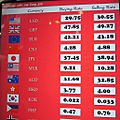ISO 4217 facts for kids

ISO 4217 is an international rule that gives special three-letter codes to all the different currencies in the world. It was created by the International Organization for Standardization (ISO). These codes are like short names for money.
People in banking and business all over the world use these codes to talk about money. In many countries, people know the codes for common currencies very well. So, when you see exchange rates in newspapers or at banks, they often use just these codes instead of the full currency names or currency symbols. For example, on airline tickets or international train tickets, ISO 4217 codes are used to make sure everyone understands the price clearly.
Contents
How Currency Codes Are Made
The first two letters of a currency code usually come from the two-letter country code for that country. For example, "JP" is for Japan. The third letter is usually the first letter of the currency's name. So, for Japan, the currency code is JPY, with "Y" for yen.
This system helps avoid confusion. Imagine if many countries used the name "dollar" or "pound"! With ISO 4217, you know exactly which dollar or pound is being talked about.
If a currency changes its value a lot, the third letter of its code might change. This helps people tell the new currency from the old one. For example, the Mexican peso code is MXN, where the "N" means "new." The Russian ruble changed from RUR to RUB.
Each currency also has a three-digit number code. This number is often the same as the number code for the country itself. For example, the United States dollar (USD) has the number code 840, which is also the number for the United States.
The ISO 4217 standard also explains how a main currency unit relates to its smaller parts. For example, 100 cents make 1 dollar. This is called the "currency exponent." For USD, the exponent is 2 (meaning 100 parts). For the Japanese yen (JPY), the exponent is 0 because it doesn't have smaller parts that are commonly used.
Special Codes
ISO 4217 also has codes for things that aren't regular currencies but are used in international finance. This includes valuable metals like gold (XAU), silver (XAG), palladium (XPD), and platinum (XPT). These are measured per one troy ounce.
There are also special codes for testing (XTS) or to show that no currency is involved (XXX). All these special codes start with the letter "X." This "X" is used because no country codes start with "X," so there's no confusion.
Some currencies used by groups of countries, like the East Caribbean dollar or the CFP franc, also start with "X." The Euro is special; its code is EUR, because "EU" is a reserved code for the European Union.
A Brief History
In 1973, a group called ISO Technical Committee 68 decided to create these currency codes. In 1978, the United Nations agreed that these codes would be great for international trade.
Currencies change over time. New ones are created, and old ones disappear. This can happen because of new governments, agreements between countries, or big changes in a currency's value. Because of this, the list of codes needs to be updated regularly. A group called SIX Interbank Clearing is in charge of keeping the list of ISO 4217 codes up to date.
Common Currency Codes
Here are some of the most common ISO 4217 currency codes you might see:
| Code | Num | E | Currency | Locations using this currency |
|---|---|---|---|---|
| AUD | 036 | 2 | Australian dollar | Australia and nearby islands |
| CAD | 124 | 2 | Canadian dollar | Canada |
| CNY | 156 | 2 | Chinese yuan | China |
| EUR | 978 | 2 | Euro | Many countries in Europe |
| GBP | 826 | 2 | Pound sterling | United Kingdom and some territories |
| JPY | 392 | 0 | Japanese yen | Japan |
| KRW | 410 | 0 | South Korean won | South Korea |
| MXN | 484 | 2 | Mexican peso | Mexico |
| NZD | 554 | 2 | New Zealand dollar | New Zealand and some Pacific islands |
| RUB | 643 | 2 | Russian rouble | Russia |
| USD | 840 | 2 | United States dollar | United States and many other places |
Unofficial Codes
Sometimes, codes that look like ISO 4217 codes are used for currencies that aren't officially recognized by the standard. A good example is Bitcoin, a digital currency:
| Code | Num | E | Currency | Locations using this currency | Notes |
|---|---|---|---|---|---|
| BTC | Nil | 8 | Bitcoin | Global (internet-based digital money) | Used on Bitcoin trading websites. |
Currencies Without ISO Codes
Some places have their own money, but it doesn't have an official ISO 4217 code. This can be for a few reasons:
- Their currency is directly linked to another country's currency (like the Cook Islands dollar is linked to the New Zealand dollar).
- The money is only made for collecting, not for everyday use.
- The place that issues the currency is not fully recognized as an independent country.
Examples include the Somaliland shilling and the Transnistrian ruble. Even without official ISO codes, some of these currencies might have unofficial codes used in business, like GGP for the Guernsey pound.
Old Currency Codes
Many currencies have been replaced over time, especially when countries joined the Eurozone. For example, the German mark (DEM), French franc (FRF), and Italian lira (ITL) were all replaced by the Euro (EUR) in 1999. Other currencies have changed their codes when their value was updated, like the Russian ruble (RUR became RUB).
Images for kids
See also
 In Spanish: ISO 4217 para niños
In Spanish: ISO 4217 para niños



